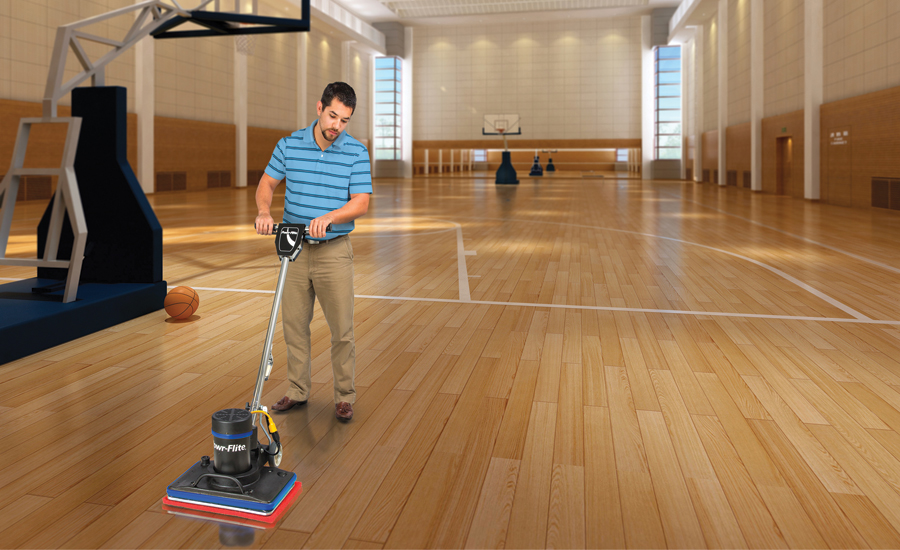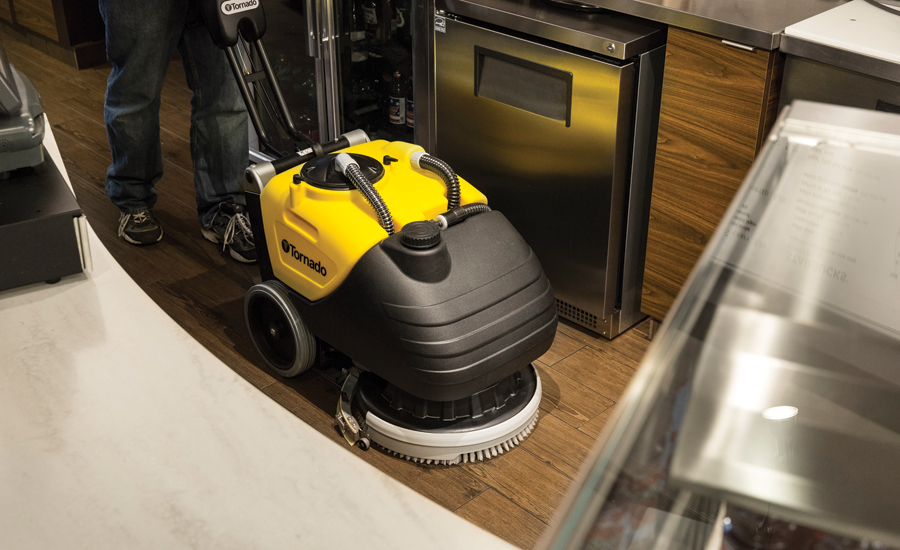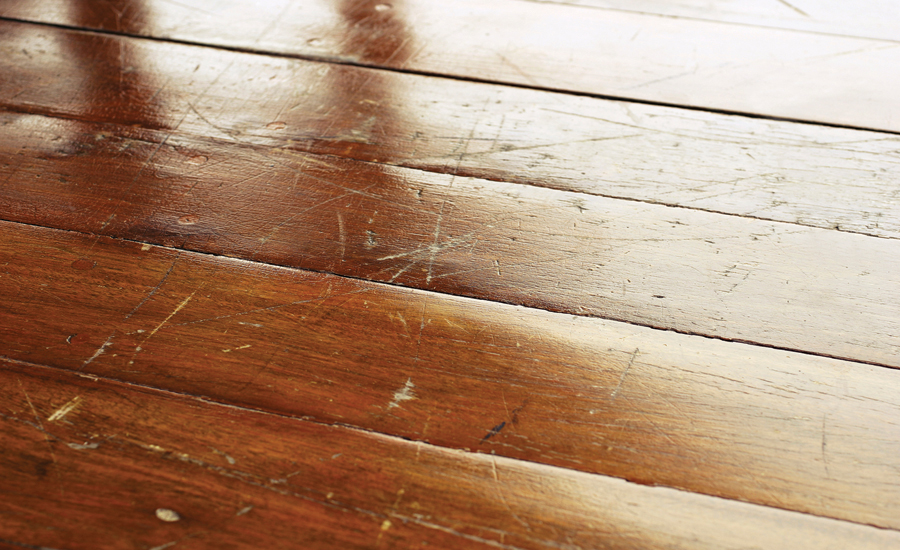The Job’s Not Over Until You Know How to Clean It










Article Index:
Because of this, now is an opportune time to cover some of the basics on many hardwood floor cleaning and maintenance issues. These topics will apply to most types of wood floors whether installed in residential or commercial locations, and many are suggested by the National Wood Flooring Association (NWFA) along with the American Hardwood Information Center. This article will further discuss some of the actual techniques, tools and equipment for hardwood floor care recommended by manufacturers of professional cleaning tools and equipment.
As with most hard surface floors, there are actually three components in professional floor care. These are:
- Daily or general maintenance
- Interim maintenance
- Refinishing
Because refinishing is very involved, our focus here will be on the cleaning and maintenance necessary on a regular basis throughout the year.
Daily or General Maintenance
In many ways, general maintenance on a daily/regular basis is actually the most important part of hardwood floor care. The better the floor is maintained on a regular basis, the more likely major floor care steps, such as refinishing, can be delayed or avoided, especially in commercial locations.
All hardwood floors should be cleaned regularly to remove soil, grit and dust, which can penetrate into the pores of the floor and floor boards. Further, with foot traffic these soils can be pushed into the floor surface, where they can actually act as daggers, cutting into the floor. One way to minimize damage from foot traffic is to add adequate walk-off mats.
Using a dust mop (dry, wet or oil-treated) is not recommended. These tend to stir dust into the air almost as much as they collect it, marring indoor air quality and causing the dust to find a home somewhere else on the floor. A damp mop should not be used on a hardwood floor and an oil-treated mop has a tendency to leave “trails” on the floor, which can mar its appearance.
Instead of mops, it is recommended that workers use a backpack vacuum cleaner. Backpacks are designed to vacuum all types of surfaces including hardwood floors, pulling dust and grit from the floor instead of pushing it from place to place.
Backpack vacuums are, as the name implies, vacuum cleaners worn on the user’s back. New technologies have made some of these systems much lighter and more comfortable to use. In addition, most backpack vacuums do not have beater bars, instead they have direct suction with the use of a brush style floor tool. Selecting a machine with a multi-stage HEPA filtration system is also suggested to ensure no dust is released into the air.
Other general maintenance items include the following:
- Wipe spills up as soon as they are noticed;
- Install as much as 15 feet of matting inside and outside the facility. This amount of matting should capture and trap 70% or more of the moisture and soils on shoe bottoms;
- Place felt pads on the bottom of furniture legs, desks, etc., and
- If the décor allows, install area rugs over the floor—especially on major walkways
Interim Maintenance
It is very important the end-user and cleaning professionals know what type of finish, if any, has been applied to the floor. Different types of finishes require different types of care.
There are essentially three types of finishes applied to hardwood floors or are specially designed to be used on hardwood floors.
- Surface finishes are made up of urethanes or polyurethanes. These finishes form a protective coating over the floor, are water-resistant, durable and typically require minimal maintenance. As practical as they are, some designers, especially of commercial locations, believe this type of finish puts too high of a luster on the floor, diminishing the natural look of the hardwood.
- Wax finishes work similarly to the finishes applied to a traditional hard surface floor. The finish soaks into the pores of the wood. As it hardens it forms a protective penetrating seal, which will appear low luster, providing a more natural look. Wax finishes are durable but are not necessarily as water and soil resistant as a surface finish.
- Acrylic impregnated finishes are found mostly in commercial settings. They provide a super-hard, very durable protective coating to the floor—strong enough that they are often used to finish hardwood floors in shopping malls and retail facilities.
As to actual cleaning, a generic hardwood floor cleaner should be effective on floors with a surface finish and some acrylic-impregnated floors. For wax finishes, only solvent-based waxes, buffing pastes and cleaning solutions made specifically for wax-finished floors should be used.
Tools and Equipment
One of the most important pieces of advice when it comes to any type of floor care is to always use clean tools and equipment. If a chemical solution does have to be applied to the floor, it is recommended to use a fresh mop head every time. This way there is no risk that chemical residue from past applications will be transferred to the floor.
Many types of hardwood floors should be machine buffed, for instance those with a wax finish or a non-urethane-based finish as mentioned earlier. Machine buffing is actually a very effective way to remove scuffmarks, along with grit and soil from the floor that may not have been or can’t be removed with vacuuming.
However, if machine buffing, the following considerations are important:
- Select a pad specially designed for floor buffing and for use on hardwood floors. Typically, the darker the pad, the coarser it is, and if it’s too coarse, it can remove the floor’s finish or even damage the floor. If you are unsure what pad to use for floor buffing, start with the least aggressive, which is usually a white, pink or beige pad.
- The machine to use in most cases is low-speed, generating 175 rpms to 320 rpms. A machine with a 1- or 1.5-horsepower motor is needed, and usually these units come in 17- and 20-inch sizes. With hardwood, the weight of the machine is also important. A heavier machine creates more contact pressure with the floor, which can improve the cleaning results and put a luster on the floor, if desired. It is important to note that creating too much down pressure with weights could cause the machine to trip a circuit breaker so always add weight incrementally versus all at once.
Floor of the Future?
It’s interesting how styles change. In the 1950s through the 1970s, most Americans wanted wall-to-wall carpeting. Carpeting was also more common in commercial applications. Now, especially in residential settings, hardwood is one of the more popular choices, and many commercial facilities also install hardwood because it is popular with millennials.
This is good news for hardwood floor manufacturers, contractors and installers. And hardwood flooring can provide natural beauty, be very durable and last for decades. However, this is very dependent on the care it receives. Today it is important to make sure the customer is well versed on how to maintain new hardwood floors.
Debby Davis is the product manager for Powr-Flite, a leading manufacturer of floor care equipment. She has extensive experience in the professional cleaning industry, especially in the area of floor care. She may be reached at (800) 880-2913 or at d.davis@tacony.com
Looking for a reprint of this article?
From high-res PDFs to custom plaques, order your copy today!










